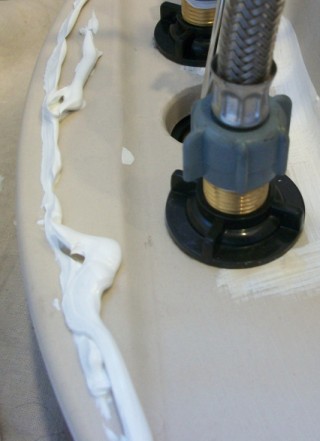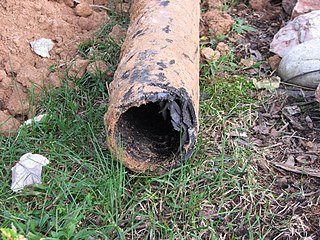Related Research Articles

Plumbing is any system that conveys fluids for a wide range of applications. Plumbing uses pipes, valves, plumbing fixtures, tanks, and other apparatuses to convey fluids. Heating and cooling (HVAC), waste removal, and potable water delivery are among the most common uses for plumbing, but it is not limited to these applications. The word derives from the Latin for lead, plumbum, as the first effective pipes used in the Roman era were lead pipes.

A gasket is a mechanical seal which fills the space between two or more mating surfaces, generally to prevent leakage from or into the joined objects while under compression. It is a deformable material that is used to create a static seal and maintain that seal under various operating conditions in a mechanical assembly.

Caulk or, less frequently, caulking is a material used to seal joints or seams against leakage in various structures and piping.

In modern plumbing, a drain-waste-vent is a system that allows air to enter the plumbing system to maintain proper air pressure to enable the removal of sewage and greywater from a dwelling. Drain refers to water produced at fixtures such as sinks, and showers; waste refers to water from toilets. As the water runs down, proper venting is required to allow water to flow freely, and avoid a vacuum from being created. As the water runs down air must be allowed into the waste pipe either through a roof vent (external), or an internal vent.

American National Standard Pipe Thread standards, often called national pipe thread standards for short, are United States national technical standards for screw threads used on threaded pipes and pipe fittings. They include both tapered and straight thread series for various purposes, including rigidity, pressure-tight sealing, or both. The types are named with a full name and an abbreviation, such as NPT, NPS, NPTF, or NPSC.
Pipeline video inspection is a form of telepresence used to visually inspect the interiors of pipelines, plumbing systems, and storm drains. A common application is for a plumber to determine the condition of small diameter sewer lines and household connection drain pipes.

A pipe is a tubular section or hollow cylinder, usually but not necessarily of circular cross-section, used mainly to convey substances which can flow — liquids and gases (fluids), slurries, powders and masses of small solids. It can also be used for structural applications; hollow pipe is far stiffer per unit weight than solid members.

A threaded pipe is a pipe with screw-threaded ends for assembly.

Thread seal tape is a polytetrafluoroethylene (PTFE) film tape commonly used in plumbing for sealing pipe threads. The tape is sold cut to specific widths and wound on a spool, making it easy to wind around pipe threads. Thread seal tape lubricates, allowing for a deeper seating of the threads, and it helps prevent the threads from seizing when being unscrewed. The tape also works as a deformable filler and thread lubricant, helping to seal the joint without hardening or making it more difficult to tighten, and instead making it easier to tighten. It also protects the threads of both pieces from direct contact with each other and physical wear and helps seal and prevent leaks from the connection.

A fitting or adapter is used in pipe systems to connect sections of pipe or tube, adapt to different sizes or shapes, and for other purposes such as regulating fluid flow. These fittings are used in plumbing to manipulate the conveyance of fluids such as water for potatory, irrigational, sanitary, and refrigerative purposes, gas, petroleum, liquid waste, or any other liquid or gaseous substances required in domestic or commercial environments, within a system of pipes or tubes, connected by various methods, as dictated by the material of which these are made, the material being conveyed, and the particular environmental context in which they will be used, such as soldering, mortaring, caulking, Plastic welding, welding, friction fittings, threaded fittings, and compression fittings.
In drilling technology, casing string is a long section of connected oilfield pipe that is lowered into a wellbore and cemented. The purpose of the casing pipe is as follows:
Directional boring, also referred to as horizontal directional drilling (HDD), is a minimal impact trenchless method of installing underground utilities such as pipe, conduit, or cables in a relatively shallow arc or radius along a prescribed underground path using a surface-launched drilling rig. Directional boring offers significant environmental advantages over traditional cut and cover pipeline/utility installations. The technique is routinely used when conventional trenching or excavating is not practical or when minimal surface disturbance is required.

Orangeburg pipe is bituminized fiber pipe used in the United States. It is made from layers of ground wood pulp fibers and asbestos fibres compressed with and bound by a water resistant adhesive then impregnated with liquefied coal tar pitch. It was used from the 1860s through the 1970s, when it was replaced by PVC pipe for water supply and ABS pipe for drain-waste-vent (DWV) applications. The name comes from Orangeburg, New York, the town in which most Orangeburg pipe was manufactured, largely by the Fiber Conduit Company. It changed its name to the Orangeburg Manufacturing Company in 1948.

The Big Inch and Little Big Inch, collectively known as the Inch pipelines, are petroleum pipelines extending from Texas to New Jersey, built between 1942 and 1944 as emergency war measures in the U.S. Before World War II, petroleum products were transported from the oil fields of Texas to the north-eastern states by sea by oil tankers. After the United States entered the war on 1 January 1942, this vital link was attacked by German submarines in Operation Paukenschlag, threatening both the oil supplies to the north-east and its onward transshipment to Great Britain. The Secretary of the Interior, Harold Ickes, championed the pipeline project as a way of transporting petroleum by the more-secure, interior route.

The Kirkuk–Baniyas pipeline is a currently defunct crude oil pipeline from the Kirkuk oil field in Iraq to the Syrian port of Baniyas. The pipeline went into operation in April 1952 and was formally opened in November.

Ductile iron pipe is pipe made of ductile cast iron commonly used for potable water transmission and distribution. This type of pipe is a direct development of earlier cast iron pipe, which it has superseded.
Cast iron pipe is pipe made predominantly from gray cast iron. It was historically used as a pressure pipe for transmission of water, gas and sewage, and as a water drainage pipe during the 17th, 18th, 19th and 20th centuries.

The US natural gas pipeline system is a complex system of pipelines that carries natural gas nationwide and for import and export for use by millions of people daily for their consumer and commercial needs. Across the country, there are more than 210 pipeline systems that total more than 305,000 miles of interstate and intrastate pipelines.

Copper tubing is available in two basic types of tube—plumbing tube and air conditioning/refrigeration (ACR) tube, and in both drawn (hard) and annealed (soft) tempers. Because of its high level of corrosion resistance, it is used for water distribution systems, oil fuel transfer lines, non-flammable medical-gas systems, and as a refrigerant line in HVAC systems. Copper tubing is joined using flare connection, compression connection, pressed connection, or solder.
References
- 1 2 3 "Robotic Technology Extends the Life of Gas Pipelines". North American Oil & Gas Pipelines. January 20, 2016. Retrieved February 26, 2018.
- 1 2 3 4 5 6 Russell, Pam Radtkr (February 12, 2018). "Cast-Iron Repairing Robot Is Game-Changer for Gas Utilities". Engineering News Record . p. 33.
- 1 2 3 4 5 6 7 Barron, James (December 28, 2017). "21st-Century Repairman: The Robot in the Gas Main". The New York Times. Retrieved February 26, 2018.
- ↑ "ULC CISBOT Utilized to Repair Gas Line Leaks Underground rather than Tear Roads up". robotglobe.org. May 22, 2015. Retrieved February 27, 2018.
- ↑ King, Nathan (September 9, 2012). "ULC Robotics Doubles CISBOT Travel Distance". The New York Times. Retrieved February 26, 2018.